Journal of
eISSN: 2373-437X


Research Article Volume 11 Issue 4
National Open and Distance University – UNAD, Colombia
Correspondence: Yuneidys Mariet Oñate Perpignan, National Open and Distance University – UNAD, Colombia
Received: August 31, 2023 | Published: October 25, 2023
Citation: Orjuela CPL, Perpignan YMO. Physicochemical and technological characterization of ten potato varieties from the Pantano de Arce region. J Microbiol Exp. 2023;11(4):107-113. DOI: 10.15406/jmen.2023.11.00397
Currently there is very little information about the potato varieties that are grown in the department of Cundinamarca so through this study we seek to identify physico-chemically ten varieties of potato that grow organically in the municipality of Subachoque (Colombia) by the Association of Agroecological Producers (ASOARCE) and from the physical-chemical characterization identify technologically what could be the use for the development of food products, in this way the raw material that is not marketed, be processed and offered in different presentations at the local and national level The aim of this research project was therefore to carry out the physicochemical characterization of ten varieties of potatoes that are organically grown in the region and to determine their technological use. The results obtained as physicochemical analyses were: a content of 32% of dry matter in the star variety of the Andes morado observing that it is within the ranges established according to several sources consulted. With regard to the percentage of moisture varieties of potatoes that were found within the established parameters the single Ica poppy (78%), creole variety Colombia (79%) and black creole (80%). As for the determination of the percentage of reducing sugars the varieties that comply with the established were the flag pepper and the yellow trumpet with a 30%, followed by the single Ica pepper (24%). On the other hand, as far as starch content is concerned, ICA single pepper (15.3%), top pepper (15.9%) and shungo puca (20.6%) were found within the established parameters. Regarding the protein content of the fresh tuber, the top poppy variety (3%), followed by the single poppy Ica, brown Andes star and yellow trumpet with a 2% meet the established parameters. It was also determined that according to the requirements of the food industry these potato varieties are potential for their processing in the frying, pre-cooked, dehydrated and starch extraction industries, among others.
Keywords: potatoes, organic crops, starch, processing, marketing
The potato is one of the most consumed crops worldwide,1 it is the fourth important agricultural product after rice, corn and wheat.2 World potato production in 2017 was close to 392 million tons (tonnes), which represents 1.8% more than in 2016 (3). In Colombia, production accounted for 0.7% of world production, but it stands out for its growth rate of 13.5% compared to the previous year, surpassing the other countries. This increase was the result of favourable conditions for cultivation in the country, such as rainfall and recovery of yields.3
Today, the potato is a food that is consumed directly. It is estimated that about 70% of the total potato production is intended for human consumption. On the other hand, processing companies demand a 6.0% for the production of foodstuffs for human consumption, 7.9% for seeds, 1.9% for animal feed (unprocessed) and 1.6% for the external market.4
The main potato producers in Colombia in their order are Cundinamarca, Boyacá, Nariño, Antioquia, Santander, which contribute with 96% of the total national production and the remaining percentage is located in Cauca, Tolima and Caldas. However, these regions produce food in the midst of difficulties.5 ASOARCE - Association of Agroecological Producers of Pantano de Arce, is a non-profit association, formed by a group of small farmers located in Vereda el Pantano of Arce in Subachoque, Cundinamarca who are dedicated to growing potato in an organic form. Its crops are located between 3,000 and 3,300 msnm within the delimitation of the Páramo de Guerrero.6
The purpose of this research project was to perform the physicochemical characterization of ten potato varieties currently organically grown in the Pantano de Arce region (Subachoque, Cundinamarca) by ASOARCE producers in order to propose and establish what would be the technological use for their subsequent marketing. It should be stressed that there is very little information about the potato varieties that are currently grown in the department of Cundinamarca so we hope that this study will be useful.
The project was developed in two phases, in the first phase were identified the physicochemical and compositional characteristics of ten varieties of potatoes produced in the region of Pantano the Arce (Subachoque, Cundinamarca), then the technological or agro-industrial potential of these varieties through their composition and physical chemical characteristics was established.
It was shown as a result that the variety that had compliance in the percentage of dry matter was the star variety of the Morato Andes with a 32%. The samples that showed a higher percentage of moisture were single ICA (78%), Colombia variety creole (79%), yellow trumpet (71%) and black creole (80%). With regard to the analysis of the percentage of reducing sugars found within the established parameters were pepper flag and yellow trumpet with a 0.30%, followed by the pepper single Ica (0.24%). As for the content of starch with the analyses carried out to potato varieties, it was noted that potatoes that meet established parameters were: single Ica, top potato, flag potato and yana shungo with an average percentage of 15.3%. In determining the percentage of protein by the variety of potatoes that presented the highest percent of protein was the top potato with a 3% being within the established ranges.
The research was descriptive and experimental, and its purpose was to carry out the physicochemical analysis of ten varieties of native potatoes that are organically grown in the region of the arce melt (Subachoque, Cundinamarca) by the producers that make up the Association of Agroecological Producers (ASOARCE). These potato varieties are easily adapted to the environment and are resistant to adverse weather conditions as they are grown at an altitude between 3,000 and 3,300 msnm.
The study determined the content of dry matter, moisture, reducing sugars, starch and total protein by applying the official methods of the Association of Analytical Chemists (AOAC) of each variety, in order to determine their technological or agro-industrial use for commercialization at the local and national levels.
For data analysis, a random experimental design was used, and the statistical analysis used to discern differences between the ten varieties of potatoes was through ANOVA analysis, establishing significant differences among the mean values observed in each of the varieties, using the Tukey test, which shows the similarity or difference between the averages of variables of the potato varieties in the case that alternate hypotheses are accepted for a 95% significance level, using software, Mititab®.
This research was carried out in two phases, as detailed below: (a) Phase I: sampling of the ten varieties of organic potatoes was carried out and subsequently a physico-chemical and compositional analysis of these varieties was performed in the nutrition laboratory of the National Open and Distance University (UNAD); the results were compared with the values in the literature. (b) Phase II: With the results obtained it was determined what is the technological or agro-industrial use of each variety, so that these can be processed or processed at an industrial level.
Phase I: physicochemical análisis
Raw material: For the research, ten varieties of potatoes originating from the Sierra de Arce region (Subachoque, Cundinamarca) that are grown organically were taken, listed below and can be seen in table 1: Single ICA, creole, creole variety Colombian, puca shungo, star of the Andes purple, Apple creole, black creole, top potato, yelow trumpet, yana shungo, peor flag.
|
Variety name |
Image |
|
SINGLE ICA |
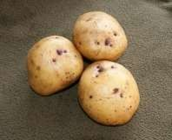
|
|
CREOLE VARIETY COLOMBIA |
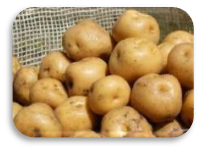
|
|
PUCA SHUNGO |
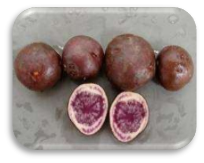
|
|
STAR OF THE ANDES PURPLE |

|
|
APPLE CREOLE |

|
|
BLACK CREOLE |
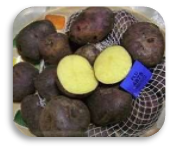
|
|
TOP POTATO |

|
|
YELLOW TRUMPET |
|
|
YANA SHUNGO |
|
|
POPE FLAG |
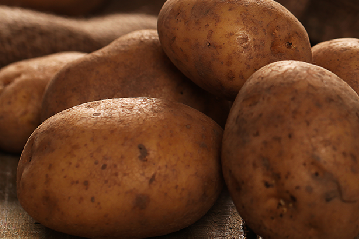
|
Table 1 Variety of potatoes
Fountain: Authors, 2019.
Procedure: Random samples of 10 kg of tubers of each of these varieties were taken to perform the physicochemical tests, these tests were tripled due to the low availability of raw material. With the aim of being able to evaluate the physicochemical characteristics, as soon as possible since the potato is a perishable product.
The analyses were carried out in fresh form and the percentage of dry matter, moisture, reducing sugar, protein and starch was determined according to the following procedure:
Dry matter: The AOAC 925.10/05 methodology described in the Association of Official Analytical Chemists was evaluated. 2g of each sample was weighed in previously tarred porcelain capsules, then the samples were taken to a drying stove at a temperature of 95-100 ºC for enough time to a steady weight. Finally, they were cooled in the dryer and subsequently weighed. From the weight of the dry matter and the fresh sample, the percentage of dry matter was calculated using the following equation:
(1)
Where: Wms= Weight of the dry matter of the unified sample and Wm= Weight of the fresh sample
Humidity: From the dry matter value found, the humidity was calculated by difference according to the following equation:
(2)
Where: %H= Moisture percentage; Wm = Weight of the fresh sample; Wms = Weight of the dry matter of the unified sample.
Reducing sugars: This was done using the Miller technique (DNS), this colorimetric method was used according to the Association of Official Analytical Chemists - AOAC 935.24/05. For the calibration curve a 1g/100ml starch pattern solution was used. The tubes were incubated for 5 min at boiling temperature (Bogotá: 92oC). They were cooled in ice water for 10 minutes in the dark. Finally, the absorption at 540 nm was read on the Spectronic 601 brand spectrometer, obtaining the slope, intersection and correlation of the calibration curve.
Almond: The method of extraction of the starch was carried out through the technique of by natural decantation is based on the methods described by Mitch (1984) and Montaldo (1984), with some modifications. The following is the starch extraction flow diagram:
The detail of the starch extraction process is described below:
The percentage of starch was calculated according to the following equation:
(3)
Where: PE: is the specific weight.
Protein: For the determination of protein, it was evaluated according to the methodology described in the Association of Official Analytical Chemists through the Kjeldahl Method, AOAC 2001.11
(4)
Where: P: weight in g of the sample; V1: volume of HCl consumed in the titration (mL)
N: HCl normal; F: Conversion factor to go from nitrogen content to protein content. For potatoes, the conversion factor is 6.25 (100/16 = 6.25).
Phase II: determination of the technological use of potato varieties
According to the results obtained from the physicochemical and compositional characterization of the ten varieties of native potatoes that are cultivated in the region of the maple swamp (Subachoque, Cundinamarca), such as ICA single, criolla, Colombia variety, puca shungo, yana shungo, purple star, apple criolla; superior potato, red heart, black creole and yellow trumpet, the second phase of research was carried out, which consisted of determining the technological or agro-industrial use of each variety, so that they can be processed or transformed at an industrial level.
Phase 1 Physicochemical Analysis: In table 2, we observe the results of the physicochemical analyzes carried out regarding the percentage of dry matter, humidity, reducing sugars, starch and protein carried out on the ten varieties of potatoes:
In table 8 and figure 3, according to the analyzes carried out on the varieties of potatoes used, it is observed that the one with the highest percentage of protein was the superior potato with 3%, followed by the Ica potato, the only star of the purple andes and yellow trumpet (2%).
|
Variety of potatoes |
Dry material (%) |
Humidity (%) |
Reducing sugars (%) |
Starch (%) |
Protein (%) |
|
Single ica |
45 |
78 |
0.24 |
15.3 |
2 |
|
Creole variety colombia |
42 |
79 |
0.09 |
27 |
1 |
|
Puca shungo |
38 |
81 |
0.04 |
20.6 |
1 |
|
Star of the andes purple |
32 |
84 |
0.21 |
28 |
2 |
|
Apple creole |
46 |
77 |
0.14 |
29.2 |
1 |
|
Black creole |
40 |
80 |
0.14 |
25.9 |
1 |
|
Top potato |
82 |
59 |
0.12 |
15.9 |
3 |
|
Yellow trumpet |
59 |
71 |
0.3 |
26.2 |
2 |
|
Yana shungo |
60 |
70 |
0.05 |
14.5 |
1 |
|
Pope flag |
64 |
68 |
0.3 |
14.7 |
1 |
Table 2 Physicochemical analysis results
Fountain: Authors, 2019.
|
Variety of potatoes |
Dry material (%) |
|
1. Single aica |
45 |
|
2. Creole variety colombia |
42 |
|
3. Puca shungo |
38 |
|
4. Purple star of the andes |
32 |
|
5. Apple creole |
46 |
|
6. Black creole |
40 |
|
7. Superior potato |
82 |
|
8. Yellow trumpet |
59 |
|
9. Yana shungo |
60 |
|
10.pope flag |
64 |
Table 3 Results Percentage of dry matter
Fountain: Authors, 2019.
|
Variety of potatoes |
Humidity (%) |
|
1. Single aica |
78 |
|
2. Creole variety colombia |
79 |
|
3. Puca shungo |
81 |
|
4. Purple star of the andes |
84 |
|
5. Apple creole |
77 |
|
6. Black creole |
80 |
|
7. Superior potato |
59 |
|
8. Yellow trumpet |
71 |
|
9. Yana shungo |
70 |
|
10. Pope flag |
68 |
Table 4 Results Moisture Percentage
Fountain: Authors, 2019.
|
Variety of potatoes |
Reducing sugars (%) |
|
1. Single aica |
0.24 |
|
2. Creole variety colombia |
0.09 |
|
3. Puca shungo |
0.04 |
|
4. Purple star of the andes |
0.21 |
|
5. Apple creole |
0.14 |
|
6. Black creole |
0.14 |
|
7. Superior potato |
0.12 |
|
8. Yellow trumpet |
0.3 |
|
9. Yana shungo |
0.05 |
|
10. Pope flag |
0.3 |
Table 5 Results Percentage of reducing sugars
Fountain: Authors, 2019.
|
Variety of potatoes |
Starch (%) |
|
Single ica |
15.3 |
|
Creole variety colombia |
27 |
|
Puca shungo |
20.6 |
|
Star of the andes purple |
28 |
|
Apple creole |
29.2 |
|
Black creole |
25.9 |
|
Top potato |
15.9 |
|
Yellow trumpet |
26.2 |
|
Yana shungo |
14.5 |
|
Pope flag |
14.7 |
Table 6 Results Percentage of starch
Fountain: Authors, 2019.
|
Variety of potatoes |
Protein (%) |
|
Single ica |
2 |
|
Creole variety colombia |
1 |
|
Puca shungo |
1 |
|
Star of the andes purple |
2 |
|
Apple creole |
1 |
|
Black creole |
1 |
|
Top potato |
3 |
|
Yellow trumpet |
2 |
|
Yana shungo |
1 |
|
Pope flag |
1 |
Table 7 Results Protein Percentage
Fountain: Authors, 2019.
|
Improved varieties |
Applications (theoretical) |
Results |
|
Single ICA |
The Single ICA potato is suitable for fresh consumption (soups, tortillas, purées and broths) and for frying stick type. |
According to the physicochemical analyzes, this type of potato variety is suitable for processing since it maintains its sensory properties, consistency and useful life. |
|
Top potato |
The SUPREMA variety is a potato that has been used mainly for fresh consumption (soups, tortillas and mashed potatoes). However, in recent years its use for frying at an industrial level has increased. |
This type of potato is used to puree and can be processed to obtain a smooth and pasty consistency. |
|
Creole |
The Criolla variety of excellent culinary quality is versatile for different dishes (soup or cream, sweaty) and widely used to fry whole). It is also processed for export fresh and frozen pre-cooked. |
The same as the pastusa potato for the industrial part and depending on its use, it is used to obtain types of puree due to its soft and pasty consistency. |
|
Yana Shungo |
The Puca Shungo variety is suitable for fresh consumption (cooked and pureed) and for frying. |
It is a potato that has great versatility in terms of its consistency and stability, since it can be used for baking, pre-fried, pre-frozen, dehydration process, baked, types of puree, flour and frying, without affecting its sensory characteristics and useful life. |
|
Puca shungo |
The Yana Shungo variety is suitable for fresh consumption (cooked, creams and purees) and for frying. |
It is a type of potato that has little industrial use due to its low moisture content, it can be used fresh, pure, and in terms of frying it can darken in the frying process. |
|
Star of the Andes purple |
The Star of the Andes purple is used for candiing, mashing, and also frying, but it is not as crunchy as the others. |
It is a potato that has great versatility in terms of its consistency and stability, since it can be used for baking, pre-fried, pre-frozen, dehydration process, baked, types of puree, flour and frying, without affecting its sensory characteristics. and useful life |
|
Yellow trumpet |
The Yellow trumpet variety is used to make chips. |
The results obtained this type of potato can be used for the part of pre-fried, type chips and flour. |
|
Apple creole |
The apple Creole variety is used for purée and due to its size it also works well in chips. |
The results obtained this type of potato can be used for the part of pre-frying, such as chips and flour. |
|
Yana Shungo |
The Yana Shungo potato variety is used for cooking and can keep its shape even after boiling or frying. |
In this type of potato it can be usedto obtain types of puree due to its smooth, pasty consistency and can also be obtained pre-fried. |
|
Black creole |
The black Creole potato variety is ideal for tortillas because the potato does not harden when it is made overnight. |
The same as the pastusa potato for the industrial part and depending on its use, it is used to obtain types of puree due to its soft and pasty consistency. |
Table 8 Technological use of potato varieties
Fountain: Authors, 2019.
It is important to clarify that the protein content in potatoes can vary because a high protein content changes the physical properties of starch pastes, influencing its viscosity and giving it a tendency to foam together with a floury aroma.
Phase 2: Technological use: The second phase of research was carried out, which consisted of determining what the technological or agro-industrial use of each variety will be, so that they can be processed or transformed at an industrial level in different presentations such as: With the previous results, the raw material that is not commercialized by ASOARCE can be transformed and offered in different presentations locally and nationally.
According to the statistical analyzes carried out on the varieties of potatoes evaluated, it was observed that the star potato of the Andes with a 32% dry matter content is within the established parameters. The factors that influence said content are the variety of the tubers, the growth, the type of minerals in the water and the absorption, the harvest period, the way in which the tuber is cultivated (organic crops), the minerals present in the soil (sodium chloride), external circumstances and, therefore, will present differences in dry matter content among other constituents. The ideal content is 25% in the case of french fries referring to fresh matter, otherwise they would cease to be commercial.
In the varieties of potatoes analyzed, the humidity method determines the quality in the conservation of the potatoes, since it can affect the stability of the product, whether fresh or processed. The varieties of potatoes that were found within the established parameters were single Ica potato (78%), Creole variety Colombia (79%) and Creole black (80%).
The reducing sugars in potatoes should not exceed 0.25% to 0.5%, when the content exceeds reducing sugar levels of 0.03 and 0.05%, depending on the varieties, browning problems occur. With the analysis carried out, it was observed that the varieties of potatoes that were found within the established parameters were: the flag potato and the yellow trumpet with 0.30%, followed by the unique Ica potato (0.24%).
Regarding the starch content, the varieties Icaúnica (15.3%), superior potato (15.9%) and puca shungo (20.6%) were within the established parameters. Potatoes that present contents lower than the established ranges (15% to 20%), it is not recommended to extract them for their subsequent transformation into starch since the starch must have a white coloration after its extraction.
Regarding the protein content, the varieties that meet the established ranges were superior potato (3%), followed by the single Ica potato, purple star of the Andes and yellow trumpet with 2%.
The potato industry demands a quality tuber, this depending on the processing objective, therefore the tubers intended for French fries must be low in reducing sugars and high in dry matter, thus avoiding unpleasant colors and flavors.
According to the requirements of the food industry, the varieties analyzed are potential for processing in the frying and dehydrating industry, among others, because it was evidenced that said tubers are within the established parameters.
None.
Authors declares that there is no conflict of interest.

©2023 Orjuela, et al. This is an open access article distributed under the terms of the, which permits unrestricted use, distribution, and build upon your work non-commercially.